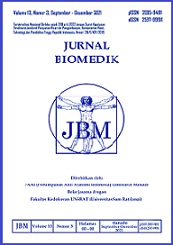EOSINOPHILIC ESOPHAGITIS Brief communication and review of the literature
DOI:
https://doi.org/10.35790/jbm.5.3.2013.4340Abstract
Abstrak: Esofagitis eosinofilik (EoE) merupakan inflamasi alergik pada esofagus yang secara klinis ditandai oleh gejala refluks, gangguan pencernaan, disfagia, nyeri perut kronis dengan kekambuhan sporadik, mual dan muntah. Sebagai penyebabnya ialah kondisi alergik terhadap alergen yang berasal dari makanan, lingkungan, atau keduanya. Dinding esofagus dipadati sangat banyak eosinofil. Kami melaporkan dua kasus EoE yaitu seorang laki-laki berusia 30 tahun dan seorang anak laki-laki berusia 11 tahun. Pemeriksaan yang dilakukan ialah esofagogastroduodenoskopi, biopsi, dan uji alergi. Diagnosis EoE ditegakkan oleh adanya eosinofil pada biopsi, dengan baku emas 15 eosinofil per lapangan pandang besar (LPB). Penelitian akhir-akhir ini mengajukan 5-7 eosinofil per LPB. Patologi EoE diduga diinduksi oleh makanan, kacang-kacangan, telur, dan kacang kedelai. Pengobatan yang diberikan ialah steroid topikal seperti fluticasone atau budesonide, dan proton pump inhibitors. Studi lanjut dibutuhkan untuk mengeksplorasi pengaruh pengobatan alergi lainnya, seperti cromolyn, allergen specific immunotherapy/desensitization, dan biological targeting eosinophils, antara lain anti IL-5. Menghindari alergen dan intervensi diet harus dilakukan serentak. Simpulan: Berdasarkan pemeriksaan yang dilakukan, diagnosis pasien-pasien ini ialah esofagitis eosinopfilik. Tantangan yang dihadapi ialah menentukan atau membuktikan alergen kausatif. Pengobatan ditujukan pada menghindari alergen, serta pemberian steroid inhalasi topikal dan proton pump inhibitors.
Kata kunci: esofagitis eosinofilik, perkembangan alergi, pengobatan alergi, eosinofil, alergi makanan.
Â
Â
Abstract: Eosinophilic esophagitis (EoE), clinically manifested with reflux symptoms, indigestion, dysphagia, chronic abdominal pain with sporadic flare ups, nausea and vomiting, is an inflammation of the esophagus, where the wall of the esophagus is congested with an abundance of eosinophils. The etiology of this EoE is the allergic condition to allergens derived from food, environment, or both. We reported two cases of EoE, a 30-year-old man and an 11-year-old boy. Their work up was comprised of esophagogastroduodenoscopy, biopsies, and allergy testing. The key to diagnosing EoE is the evidence of eosinophils in a performed biopsy, the gold standard being 15 eosinophils per high power field (eos/hpf). Recent studies suggest decreasing the standard to 5-7 eos/hpf. The pathology of EoE is thought to be induced by food and environmental allergens; the most causative food allergens in EoE would be cow’s milk, nuts, eggs, and soy. The treatments typically employ topical steroids, such as Flovent (fluticasone) or Pulmicort (budesonide), and proton-pump inhibitors. More research is needed to explore the efficacy of other allergy treatments, such as cromolyn, allergen specific immunotherapy/desensitization, and biological targeting eosinophils, such as anti IL-5. Allergens avoidance and dietary intervention should be concomitantly used. Conclusion: Based on all the tests performed, the diagnosis of the patients was eosinophilic esophagitis. The challenge is to be able to determine or prove the causative allergens. Treatment usually includes avoidance of allergens, topical inhaled steroids, and proton-pump inhibitors.
Keywords: eosinophilic esophagitis, allergy work up, allergy treatment, eosinophils, food allergy.
Downloads
Issue
Section
License
Penyunting menerima sumbangan tulisan yang BELUM PERNAH diterbitkan dalam media lain. Naskah yang masuk dievaluasi dan disunting keseragaman format istilah dan cara penulisan sesuai dengan format penulisan yang terlampir dalam jurnal ini.
Segala isi dan permasalahan mengenai tulisan yang yang diterbitkan dalam jurnal menjadi tanggung jawab penuh dari penulis.







